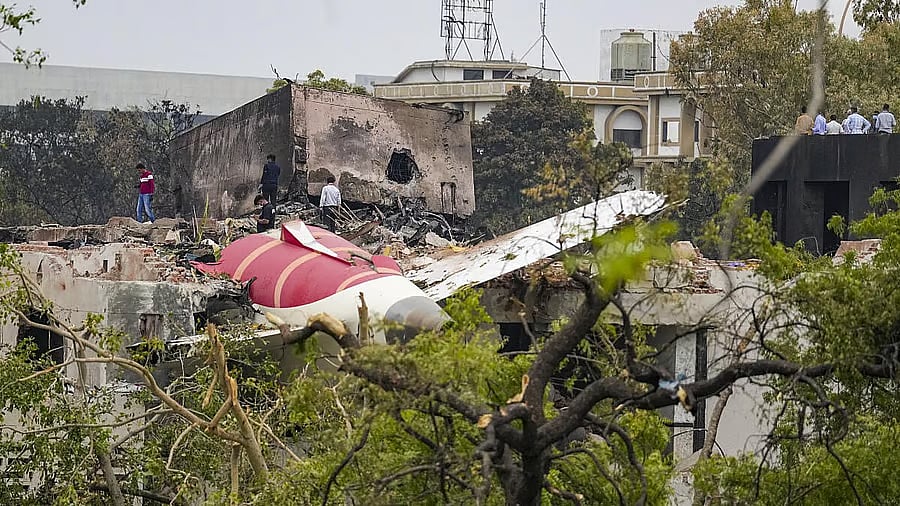
Remains of the crashed Air India plane lie on a building, in Ahmedabad.
Credit: PTI Photo
According to the 2024 Annual Safety Report of the International Air Transport Association (IATA), the accident rate
for that year was 1.13 accidents per million flights, thus making air travel the safest mode of transportation. The tragic, fatal glide of AI 171, a flight that had just taken off from Ahmedabad for Gatwick is a reminder that air accidents are improbable, but not impossible.
The airframe was a Boeing 787 Dreamliner, the first of which flew in 2009 and which entered service in 2011. Since then, Boeing has made 2,500 plus sales of the type of which nearly 1,200 have been delivered. The 787 has an excellent safety record so far and this is the first fatal, hull accident of the type ever.
Social, print, and electronic media are rife with conjecture about what could have gone wrong. A single one-minute video clip, providentially captures the terminal 17 seconds of the flight in air and its presence on social media is like an Agatha Christie-an brainteaser that is challenging the layman, the air travel enthusiast, and the hardened aviation professional.
The initial conjectural theory evoked the 2009 accident of US Airways Flight 1549 involving an Airbus 320 which lost power on both engines after take-off from LaGuardia due to the ingestion of birds into both engines. The subsequent ditching on River Hudson miraculously saved the lives of all 155 persons on board and was immortalised in the movie Sully, named after the flight’s captain Sullenberger. The probability of both engines failing in flight is infinitesimally small although within the realm of the possible. However, there was no unusual bird activity reported during the time of take-off and there is no indication of engine malfunction in the available video.
A single-engine scenario was also ruled out as the video shows no yaw which would have resulted from asymmetric engine power. This was further consolidated by the fact that satellite pics of the accident site show that it is more or less directly on the take-off heading (on Runway 23) and that the flight had not veered off to one side.
The viral video clip offers some significant but baffling information. According to the ADS-B transponder
on board the aircraft, it attained a maximum altitude of 625 feet. Under normal circumstances, the aircraft would have used flaps for take-off (to augment lift) and then progressively
reduced the amount of
flaps as it started climbing. Also, when the Vertical Velocity Indicator started indicating a positive rate of climb, the undercarriage would have been retracted. Perplexingly, the undercarriage continued to be down and the crew does not appear to have retracted it.
The flaps were in
Also, the video clearly shows that the flaps were fully in (i.e. zero flaps) during the last few seconds of the flight. Two possibilities exist. First, the crew selected the wrong configuration of flaps for take-off; this possibility appears far-fetched given the Captain’s 8,200 hours of experience. The second is that when the Captain asked the first officer to retract the undercarriage, he retracted the flaps to zero position. This would probably have resulted in a power-on stall as the wings stopped producing adequate lift for that speed due to the retracted flaps and the high drag of the still-down undercarriage.
Failure of both engines simultaneously and the maximum altitude of 625 feet present another herring to chase. Could the main fuel supply valve have been shut off after take-off? If so, that would explain the simultaneous engine failure as the fuel in the pipelines would be enough for 30 to 40 seconds which would probably take the aircraft to 625 feet after which the engines would provide no thrust and the aircraft would be glided to the best of the Captain’s ability. This theory is also somewhat supported by the statement of the sole survivor who said he realised something was wrong after about 30 seconds of take-off.
A wild card theory is that the Fly-By-Wire command to the throttles misbehaved during take-off; there is no manual override for the throttle Fly-By-Wire commands.
The flight’s black box has been found and is under analysis and will, undoubtedly, provide a definitive resolution. One thing that is a certainty is that 100% air safety is a concept akin to infinity – it can be imagined and used as a mathematical premise but never achieved. Airlines and maintenance agencies have other lessons to draw from accidents: that air safety is a continual process and the guard can never be let down.
(The writer is a former Chief Operations Officer of an airline)